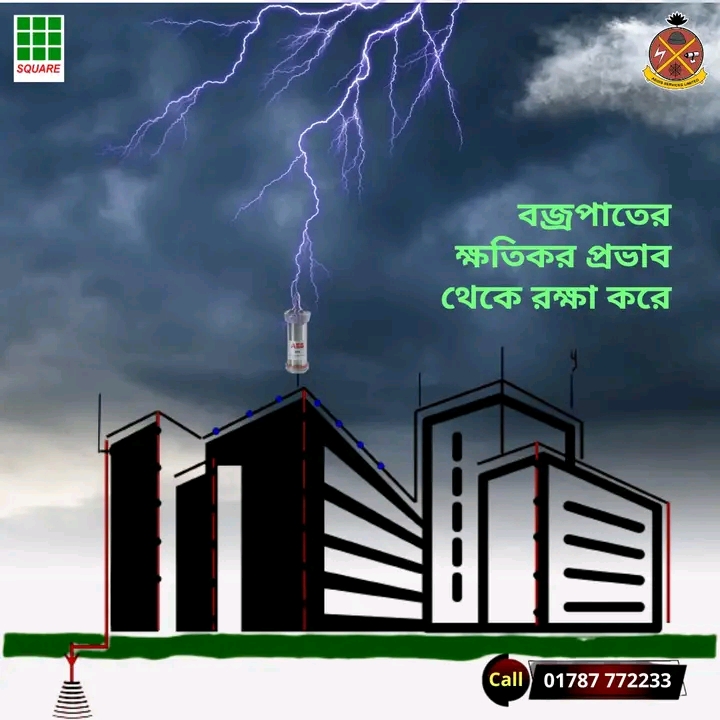As a building owner or authority, have you ever experienced thunder damage due to not installing a lightning protection system for a building, home or office? If you answer yes, many others may have the same condition. When your neighbourhood is already set up, a thought may be provoked in your mind about how lightning protection systems protect structures.
Can a LPS reduce life hazards in structures? A (LPS) is designed to help prevent damage caused by lightning strikes to structures, such as buildings, and to protect the occupants and contents within from the devastating effects of lightning strikes.
A lightning strike can cause significant damage to property, including power surges, fire, and shock waves. In this article, we will discuss how an LPS can help prevent damage caused by thunder.
How Lightning Damages Property
Before we can understand how do lightning protection systems( LPS) works, it’s important to understand how lightning can damage property. When lightning strikes a building, it can cause power surges that can damage electrical equipment and appliances. Lightning can also start fires that can destroy the structure and everything inside. Shock waves from lightning strikes can also cause damage to buildings and their occupants.
How lightning protection systems protect structures: LPS Works
LPS is designed to prevent lightning strikes from causing damage to buildings and their occupants. The system works by using lightning rods, grounding, and surge protection.
While an LPS cannot prevent lightning from occurring, its purpose is to provide a safe path for the electrical discharge of a lightning strike, minimizing the risk of fire, structural damage, and harm to people. Here’s how a Lightning Protection System works and its key components:

Lightning Protection System Components :
Air Terminals (Lightning Rods):
These are metal rods installed at the highest points of a structure. They serve as the preferred point of contact for a lightning strike.
Conductors (Lightning Conductor Cables):
Metal cables connect the air terminals to the ground, providing a path for the lightning discharge to follow.
Grounding System:
The system comprises a grounding electrode network (rods or plates) buried in the ground. The conductors are connected to the grounding system to dissipate electrical energy into the environment safely.
Surge Protection Devices:
It was installed at entry points of electrical and communication systems to prevent transient overvoltage caused by lightning from damaging connected equipment.
Benefits of LPS(Lightning Protection System)
Path of Least Resistance:
Lightning follows the path of least resistance. The Lightning Protection System helps guide the electrical discharge away from the structure by providing a direct, low-resistance way to the ground
Protecting Electrical and Electronic Systems:
Lightning-induced surges can damage electrical and electronic appliances within a building. Surge protection devices integrated into the Lightning Protection System help safeguard these systems by diverting excess voltage to the ground.
Preventing Fire and Structural Damage:
When lightning strikes a structure without a Lightning Protection System, it can cause fires, explosions, and structural damage due to the intense heat generated by the electrical current. The LPS helps prevent such damage by safely conducting the lightning energy away from the building.
Ensuring Safety for Occupants:
Lightning Protection Systems significantly reduce the risk of injury to occupants by preventing lightning-induced from shock waves, fires and structural damage. The system helps create a safer environment during a lightning storm.
Code Compliance:
In many regions, compliance with building codes requires the installation of Lightning Protection Systems, especially for tall structures, historical buildings, and critical infrastructure.
Limitations of LPS
While LPS can be an effective way to protect buildings and occupants from lightning strikes, it does have its limitations. The cost of installing an LPS can be high, and the installation process can be complex. Additionally, the system requires regular maintenance to ensure that it continues to function properly.
Types of Lightning protection System:
While in market, there’re two types of lightning protection system.
- Conventional : It is designed to redirection(create a path for lightning to follow).As it is easy to use so widely used and relatively easy to install
- Non-Conventional : The designers made a system architecture to prevent lightning threat to impact on surface. The cost is high due to sophistication and offers enhanced protection.
Lightning protection system by application:
A market statistics found LPS applications in various sectors. From the perspective, Residential Building, Commercial Building, Industrial Building, Electrics, Transportation Industry, Other are main area of LPS installment.
Effectiveness of LPS System Installation:
Current market research or case studies demonstrate that the growth rate is due to moving towards green buildings and sustainable structures. Major LPS producers like ABB, DEHN International, Siemens, and Eaton’s increasing sales growth proves the necessity and impact of lightning prevention for homes, wind tunnels, solar panels, trees, etc.
Emerging Sector of LPS:
As global renewable energy consumption is on the rise, like wind turbines and solar panels, the LPS market is fueling. Moreover, people now demand advanced technologies such as early streamer emission (ESE) systems and new lightning detection and warning systems. As we have seen, lightning threats are occurring more than ever, so facility authorities with critical infrastructures like telecommunication tower buildings, airports, and data centres are now worried about safety.
Wrapping up:
It’s important to note that while Lightning Protection Systems are highly effective, they do not attract lightning. Instead, they provide a controlled path for the discharge to follow. Additionally, regular inspection, maintenance, and compliance with established standards are essential for the continued effectiveness of the Lightning Protection System.
Ultimately, a Lightning Protection System aims to reduce the risk of lightning-related damage to structures.
While there are limitations to LPS, the benefits of lightning protection system installation Bangladesh far outweigh the cost and effort required. If you’re concerned about lightning strikes damaging your property, it’s worth considering installing an LPS. Aegis is here for your lightning protection system near me service.






Leave A Comment